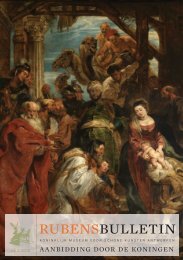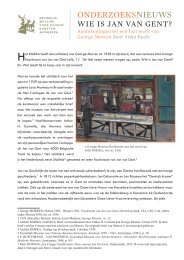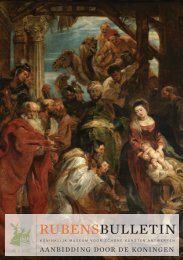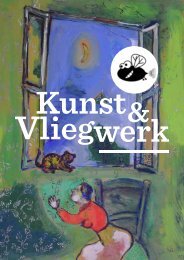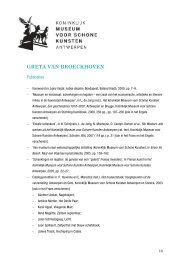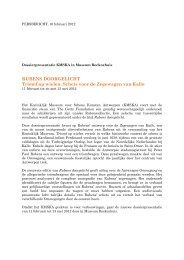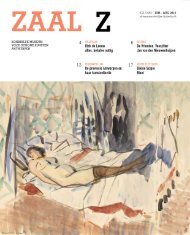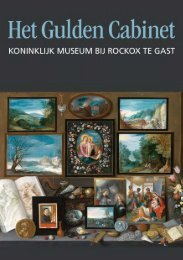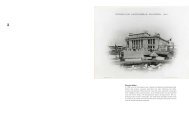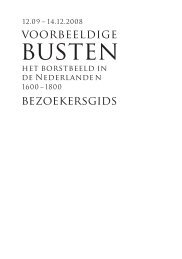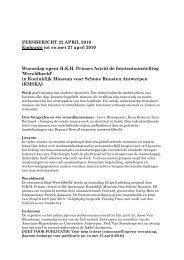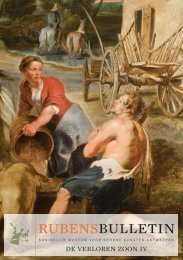visitors' guide to the presentation (PDF, 341 kB) - Koninklijk Museum ...
visitors' guide to the presentation (PDF, 341 kB) - Koninklijk Museum ...
visitors' guide to the presentation (PDF, 341 kB) - Koninklijk Museum ...
Create successful ePaper yourself
Turn your PDF publications into a flip-book with our unique Google optimized e-Paper software.
8<br />
Theodoor van Thulden (attributed <strong>to</strong>), Triumphal Arch of Philip IV,<br />
facade, 17th century, oil on panel, Antwerp Royal <strong>Museum</strong> of Fine<br />
Arts.<br />
This work is a copy of a lost Rubens sketch of <strong>the</strong> Triumphal Arch of<br />
Philip IV, on <strong>the</strong> occasion of <strong>the</strong> State Entry of Cardinal-Infante<br />
Ferdinand of Austria (1635). For <strong>the</strong> new governor’s state entry in<strong>to</strong><br />
Antwerp, <strong>the</strong> city was decorated with temporary triumphal arches<br />
designed by Rubens. The Triumphal Arch of Philip IV, a homage <strong>to</strong> <strong>the</strong><br />
Spanish king, was erected at <strong>the</strong> end of <strong>the</strong> Huidevettersstraat. Theodoor<br />
van Thulden (1606-1669) <strong>to</strong>ok part in <strong>the</strong> work preparing <strong>the</strong><br />
festive decorations for <strong>the</strong> State Entry and based his engravings on<br />
<strong>the</strong>se compositions.<br />
The Triumphal Arch, a wooden construction about 21 meters high,<br />
glorified <strong>the</strong> Habsburg dynasty and illustrated how <strong>the</strong> Ne<strong>the</strong>rlands<br />
came <strong>to</strong> be ruled by King Philip IV, <strong>the</strong> bro<strong>the</strong>r of <strong>the</strong> Cardinal-<br />
Infante. The arch had three passageways, separated by columns and<br />
pilasters set on high bases. The large tableau above <strong>the</strong> central passageway<br />
portrays <strong>the</strong> marriage of Maximilian of Austria and Maria of<br />
Burgundy, daughter and heir of Charles <strong>the</strong> Bold. As a result of this<br />
marriage, <strong>the</strong> Ne<strong>the</strong>rlands passed <strong>to</strong> <strong>the</strong> Habsburgs. The group of<br />
figures crowning <strong>the</strong> whole – <strong>the</strong> supreme Roman god Jupiter with his<br />
wife Juno – emphasises <strong>the</strong> his<strong>to</strong>rical importance of this marriage.<br />
Around <strong>the</strong> central arch are depicted <strong>the</strong> six Habsburg rulers over <strong>the</strong><br />
Ne<strong>the</strong>rlands, and at <strong>the</strong> <strong>to</strong>p, <strong>the</strong> ances<strong>to</strong>rs of Philip IV: Emperor<br />
Maximilian 1, Philip <strong>the</strong> Handsome, Philip II and Emperor Charles<br />
V; below <strong>the</strong> Emperors stand Philip III and Philip IV. The wedding<br />
scene and <strong>the</strong> six portraits were all separate paintings placed in <strong>the</strong><br />
wooden triumphal arch. The his<strong>to</strong>rical piece was painted by Jacob<br />
Jordaens, and <strong>the</strong> six portraits by Cornelis de Vos. The wedding scene<br />
(10)




